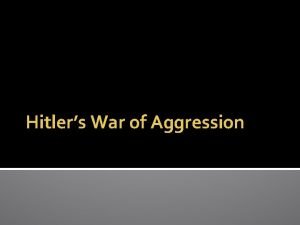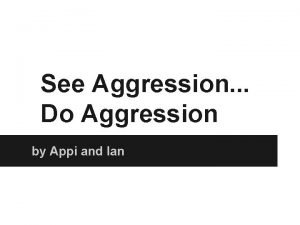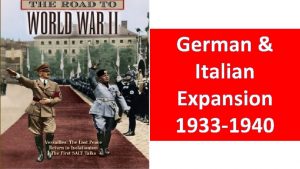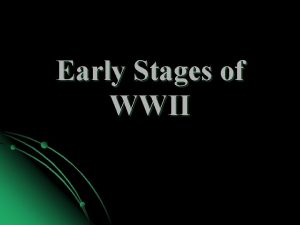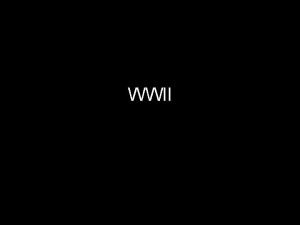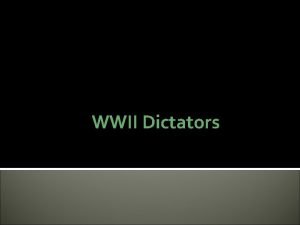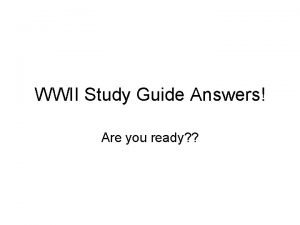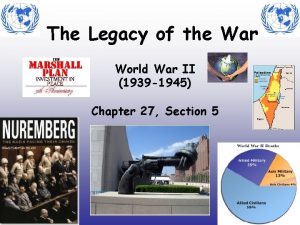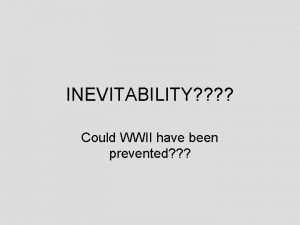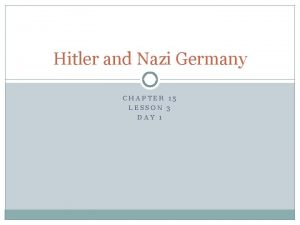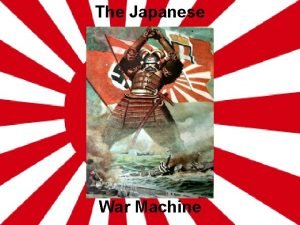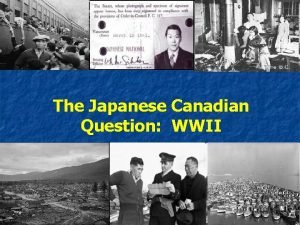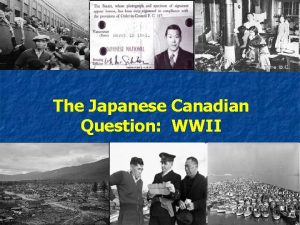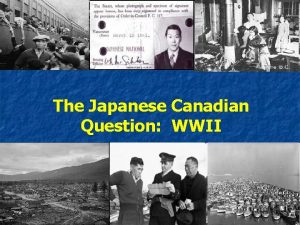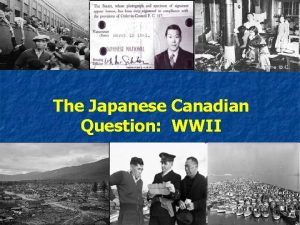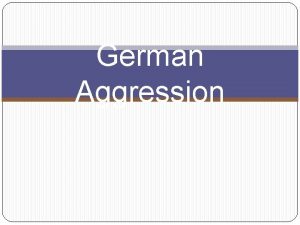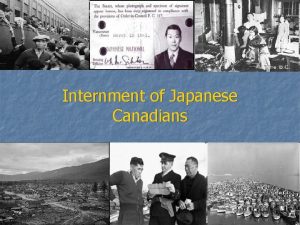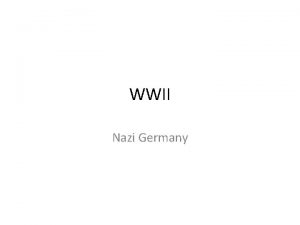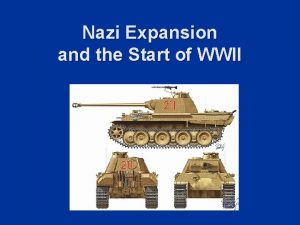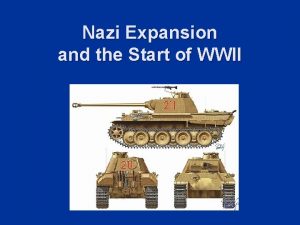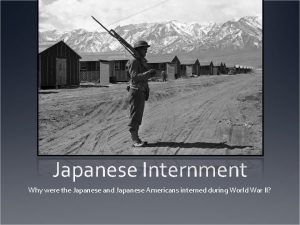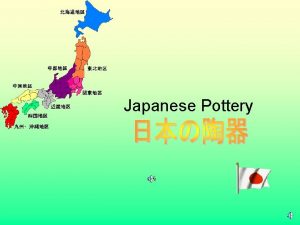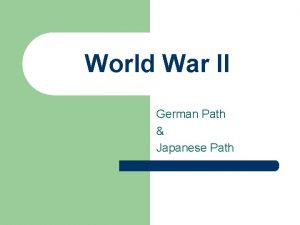WWII an Introduction Nazi German Aggression Japanese Expansion
























- Slides: 24

WWII: an Introduction Nazi German Aggression Japanese Expansion U. S. Battles in the Pacific and Europe

WWII Fought in much of Europe- almost every country in Europe saw violence during WWII Fought throughout Southeast and East Asia as British and American forces neutralized and weakened Japanese forces U. S. manufactured a little over 297, 000 aircraft for WWII U. S. manufactured over 300 destroyers, 27 aircraft carriers, over 200 submarines for WWII The deaths of loved ones was staggering, leaving millions of people fatherless, childless, motherless, etc… Of those who were killed in WWII, roughly 67% were civilians Roughly 72 million deaths worldwide during WWII Estimated number who served during WWII: 1. 9 billion German civilians killed: over 1 million Japanese civilians killed: roughly 672, 000 Russian civilians killed: over 12 million 405, 000 US military deaths in WWII 11 million Soviet military deaths 5. 5 German military deaths Over 400, 000 British military deaths Over 500, 000 British civilian deaths Statistics tell the magnitude of deaths and production during war, but the story of WWII is a human story

Events that led to WWII

• Martin Bormann • Inhumane, power hungry individual • In Hitler’s ear on a constant basis • Manipulative, deceiving • Reichsminister-head of affairs below Hitler • Isolated from contact w/ outside world • Reichsminister SS: Heinrich Himmler • Believed to have as much influence as Hitler • Former salesman- did not fight in WWI • Joined party in 1923 • Believed Third Reich’s role was to: • “…eliminate harmful elements to German society…” • Harmful elements included all ‘inferior races’ that would minimalize Germanization

SS-(Schutz. Staffel) Rally in Nuremberg

• Reinhard Heydrich • Chief of Reichs security • SD- Sicherheitsdients • Head of Gestapo • Worked under Himmler/SS Geheime Staat Polizei State Secret Police Secret Service

Nazi Germany Foreign Policy

Nazi Racial Policy Jews and Slavs inferior (Slavic population found in Eastern Europe) In past centuries Jews could be baptized to avoid persecution or discrimination, but this practice changed during Nazi rule It should be noted that the mere fact of being baptized to avoid persecution, is of itself, a wrong thing to encourage people to do February, 1933: Hitler vocalized his disdain for Slavs and discussed “living space in the East” had to be conquered All Slavic people would have to be ‘Germanized’ (ruthlessly and w/out question) No one was ‘Germanized’, rather people were enslaved or brutally murdered Mein Kampf: war with Russia was ideological war w/ Communism & race war against Jews All these matters were that of the Fuhrer- Nazi gov’t became increasingly Hitler’s gov’t

Treaties and Actions- Nazi Germany Non-Aggression Treaty Poland: 1934 Meant to break open Germany’s isolation Poland France would not encircle Nazi Reich Berlin-Rome Axis: 1936 Italian & German fascism differedbut they were both expansionists Mussolini would tolerate German “influence” (aggression) in the Alps Reoccupation of the Rhineland: 1936 In January, 1936 - 90% of inhabitants of Saarland voted for return to German Reich March, 1936 - German troops marched into Rhineland took back demilitarized zone

Continual Aggression of Nazi Germany Austrian Anschluss, 1938 Re-occupation of Rhineland- 1936 March into Sudetenland, 1938 Conquer Czechoslovakia, 1939 September, 1939: Launched war against Poland Battle for Britain, August 1940 massive air bombardment against England Invasion of Norway & Denmark, April 1940 June, 1940: Paris occupied Invasion of Benelux, May 1940



Nazi Occupied Territory

Timeline: Nazi Expansion 1936: Nazi Germany invaded Rhineland 1938: Sudetenland taken over by German forces 1938: Nazi Germany annexes Austria 1939: Nazi Germany conquered all of Czechoslovakia 1939: Non-aggression Pact w/ Stalin September 1, 1939: Germany invades Poland April 1940: Denmark invaded & Norway invaded May 1940: German paratroopers dropped on Belgium, Luxembourg & Holland May 1940: German troops surged into France July 1940: six months RAF and German Luftwaffe battled in the air (Battle of Britain)

Japanese Expansion 1932: Japan invades Chinese province. Manchuria; Shanghai follows 1938: NE China controlled by Japanese forces 1940: Japanese forces stationed in French Indochina (modern Vietnam) By 1941: Indonesia, Malaysia, Philippines & Dutch East Indies

Imperial Powers, 1939

Japanese Imperialism

War in the Pacific Battle of Coral Sea 5 -day battle; fought thru the air; stopped Japanese assault on Australia Battle at Midway Japanese set out to capture Aleutian Islands; wanted to capture Midway Atoll for airbases & destroy U. S. aircraft carriers Battle fought thru the air and focused on aircraft carriers; 322 Japanese planes destroyed and 4 Japanese aircraft carriers destroyed Battle at Guadalcanal July of ‘ 42: Japanese forces continued quest for Australia; Australian forces beat Japanese forces At the same time, U. S. forces detected Japanese airbase at Guadalcanal; 16, 000 U. S. infantry given task to invade island, capture airfield Battle raged for 6 months; fought on sea, air and land; Japanese surrendered island after months of attrition Battle at Tarawa November ‘ 43: U. S. Marines suffered high casualties in assaulting island; improved Allied amphibious landings, implemented changes in pre-invasion bombardment; increased careful planning of tides & landing craft schedules Battle at Iwo Jima Japanese defended island with tunnels, hidden artillery & bunkers; some of the more fiercest fighting occurred on this island; first U. S. attack on an Japanese home island; 20, 000 of 22, 000 Japanese troops killed; battle lasted 35 days; island finally taken and airfields used for bombing runs over Japan Battle at Leyte Gulf October 1944: largest naval battle in history of warfare; last naval battle in current history; Kamikaze pilots were used for the first time in this engagement; Victory secured the beachheads for the 6 th Army’s invasion of Philippines; Battle at Okinawa March-June 1945: largest amphibious invasion of WWII; Japanese lost 100, 000 troops; U. S. roughly 12, 000; ¼ of civilian population killed; “Typhoon of Steel”; Okinawa would serve as springboard to


Images from Okinawa


War in Europe Allied Invasion of Northern Africa Operation Torch, Nov. 1942 Drove Germans from controlled territory in Northern Africa by 1943 Allied Invasion of Italy July, 1943: Allied invaded Sicily w/ 160, 000 troops; served as invasion point into Italy; Italy surrendered to Allies; Germany moved quickly to defend Italy on its own Allies had to fight thru mountains to contain road leading to Rome; fierce and defended well by Germans; U. S. finally broke thru in May, 1944 Invasion of Nazi Occupied France D-Day, June of 1944 The largest amphibious invasion in the history of war Goal was to drive Germans back from their defensive positions along the coast in order to open up landing spots for US and British weapons, men, and food supplies Battle of the Bulge German counterattack in December of 1944


 German aggression september 1938
German aggression september 1938 Nazi aggression map
Nazi aggression map See aggression do aggression
See aggression do aggression See aggression do aggression
See aggression do aggression International response to german aggression
International response to german aggression Low german vs high german
Low german vs high german German and italian expansion
German and italian expansion Pah!
Pah! Advances in technology during wwii
Advances in technology during wwii What is nye committee
What is nye committee Wwii picture
Wwii picture Wwii picture
Wwii picture Wwii study guide
Wwii study guide Source analysis
Source analysis Wwii show
Wwii show 1500 dead in hawaii congress votes war
1500 dead in hawaii congress votes war Causes of ww2
Causes of ww2 Wwii
Wwii Could wwii have been prevented
Could wwii have been prevented Wwii test review
Wwii test review Ww2 apush dbq
Ww2 apush dbq Vivienne westwood destroy nazi shirt
Vivienne westwood destroy nazi shirt William golding nazi
William golding nazi William golding
William golding Lesson 3 hitler and nazi germany
Lesson 3 hitler and nazi germany

